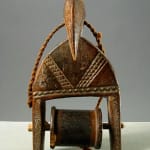Senufo Hornbill Heddle Pulley, 20th Century CE
Wood
3.25 x 5.5
PF.5827
Further images
'Nobody likes to live without beautiful things,' replied a Guro weaver when asked why he hung a decoratively carved pulley on his wooden post loom set up beneath a mango...
"Nobody likes to live without beautiful things," replied a Guro weaver when asked why he hung a decoratively carved pulley on his wooden post loom set up beneath a mango tree. The decorative features of West African heddle pulleys -- devices that hold the heddles in looms -- are created solely for aesthetic satisfaction, and have no ritual or magical purpose. The delicately carved figure on the pulley peers down at the weaver as he works and becomes his constant visual companion. The formal composition of these small pieces shows great virtuosity and variation: the artists strive for originality, ingenuity, elegance, and imaginative effects.
Naturalistic faces occur rarely on pulleys. Senufo artists draw upon a wide repertoire of facial styles that appear on statues for spirits and masks. This heddle pulley takes on the form of the elongated beak of the hornbill. The Senufo refer to the hornbill as the "master among the birds" because of its sexuality (the phallic beak) and intelligence. "Master," as a title in the men's Poro society, connotes intelligence, creativity, and mastery of a particular skill, such as weaving. The shape of the bird shown here is abstract and imaginative; it also shows the delicacy, smoothness of finish, and skillful composition that are prized by African carvers.
Naturalistic faces occur rarely on pulleys. Senufo artists draw upon a wide repertoire of facial styles that appear on statues for spirits and masks. This heddle pulley takes on the form of the elongated beak of the hornbill. The Senufo refer to the hornbill as the "master among the birds" because of its sexuality (the phallic beak) and intelligence. "Master," as a title in the men's Poro society, connotes intelligence, creativity, and mastery of a particular skill, such as weaving. The shape of the bird shown here is abstract and imaginative; it also shows the delicacy, smoothness of finish, and skillful composition that are prized by African carvers.





